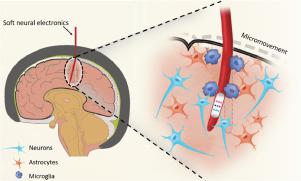Giant ( IF 5.4 ) Pub Date : 2021-08-21 , DOI: 10.1016/j.giant.2021.100075 Chuanrui Chen 1 , Xuemei Sun 1 , Huisheng Peng 1

|
Neuroscience aims at gaining a better understanding of the mechanism and function of neural systems, but its development is usually limited by the available tools to probe and stimulate the neural system. Advanced electronic devices can receive and send physical/chemical signals from and to biological systems, thus opening opportunities for neuroscience. However, the soft mechanical nature of neural tissue poses challenges for conventional rigid electronics, as the implantation of stiff electronic devices causes a mixture of side effects, including immunoreaction, chronic damage to the surrounding tissue and device dysfunction. The emerging soft electronics offer promises to solve the mechanical mismatch between artificial devices and soft neural tissues. With multiple functions integrated, they are beneficial to complex behavior studies. In this perspective, we summarize the current design principles of soft neural electronics and give an outlook on future possibilities.
中文翻译:

软神经电子学的兴起
神经科学旨在更好地了解神经系统的机制和功能,但其发展通常受到探测和刺激神经系统的可用工具的限制。先进的电子设备可以从生物系统接收和发送物理/化学信号,从而为神经科学开辟了机会。然而,神经组织的软机械性质给传统的刚性电子设备带来了挑战,因为植入刚性电子设备会导致多种副作用,包括免疫反应、对周围组织的慢性损伤和设备功能障碍。新兴的软电子设备有望解决人工设备和软神经组织之间的机械不匹配问题。由于集成了多种功能,它们有利于复杂的行为研究。









































 京公网安备 11010802027423号
京公网安备 11010802027423号